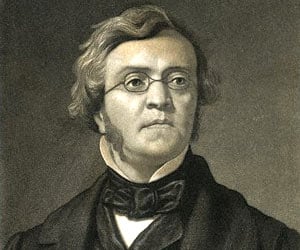William Makepeace Thackeray
| Famous as | Author & Novelist |
| Born on | 18 July 1811 |
| Born in | Kolkata, India |
| Died on | 24 December 1863 |
| Nationality | United Kingdom |
| Works & Achievements | Vanity Fair |
Childhood & Early Life
William Thackeray was born on 18 July 1811 in Calcutta, India. His
father Richmond Thackeray was a high rank secretary to the board of
revenue in the British East India Company. Anne Becher, his mother was
also a secretary writer for the East India Company. At age five, William
went on attending his first school St. Helena and then at Charterhouse
School, which he loathed in part due to the teasing he was subjected to
there. His abhorrence for the school is evident in his later fictions
where he chose to call it mockingly a "Slaughterhouse". Upon completion
of the initial school, he went on to study at Trinity College, Cambridge
but left it in the middle of the session in 1830. Around this period,
he had started writing for the college magazine The Snob and The
Gownsman.
After an extensive trip to
Paris and Weimar, he returned to England and enrolled at the Middle
Temple to study law. Once again he gave up, leaving the college soon.
Upon inheriting his father's assets at the age of 21, he invested in two
newspapers The National Standard and The Constitutional and lost
the money The National Standard and The Constitutional as they crumpled
down soon. He worsened the condition by investing in banks that were at
the verge of becoming insolvent and when this happened, he was coerced
to find a job to support himself. For sometime, he worked as an artist.
Marriage & Early Career
Thackeray courted and on 20 August 1836, married Isabella Gethin Shawe, daughter of Mathew Shawe, a colonel. The marriage
forced him to find a viable and stable source of income and he finally
got a job with Fraser's Magazine. As a journalist, he wrote art
criticism alongside contributing sketches. During this period, he
produced two fictional works Catherine and The Luck of Barry Lyndon. He
began working for a magazine Punch, publishing The Snob Papers. The
works would later become known as The Book of Snobs.
The book gave him initial success and fame, however, the happiness
was overshadowed by the growing illness of his wife, who had reached in
her last phase of depression. In
1840, he took his wife to Ireland in a hope to improve her condition,
though it hardly helped him in the matter. She threw herself in to the
sea on their way to Ireland and was rescued by the sea men. Two years
after in 1842, she was confined in a home in Paris, where she lived
until her death in 1893.
Later Career & Success
By as early as 1940, Thackeray had gained popularity with the
release of his two travel books The Paris Sketch Book and The Irish
Sketch Book. His landmark success came in 1847, when the novel Vanity
Fair was first published and soon became one of his most remembered
works. With the stunning success of the novel, Thackeray reached at the
peak of his success and produced a number of large novels including
Pendennis, The Newcomes, and The History of Henry Esmond. In 1849, he
suffered from a deadly attack of illness which left him bedridden for
months. Despite his ailing health and reduced energy, Thackeray
continued lecturing at various Universities and seminars.
In 1860, he was made editor of the Cornhill Magazine. Though he preferred the role of a columnist and continued to contribute his Roundabout Papers for the magazine. By this time, his health had worsened and he began showing the similar traits of depression as his wife's, partly motivated by the frustration from his reduced creativity. His over eating and addiction to black pepper further damaged his digestion and made him a heart patient. On the night of 23 December 1863, the author attended a dinner party and was found dead in his bedroom the next morning. He was fifty two years old at the time of his death. A funeral was held at Kensington Gardens and he was buried on 29 December at Kensal Green Cemetery.
Notable Works
Initially known as a satirist and parodist, Thackeray used pseudonyms as Charles James Yellowplush, Michael Angelo Titmarsh and George Savage Fitz-Boodle for his early writings. Timbuctoo, published in 1829, is one of his best satirical works. Another satirical work, a collection of fictional sketches appeared in Fraser's Magazine entitled as The Yellowiplush Papers in 1837. The work was adapted for BBC Radio 4 in 2009. Thackeray's first successful venture as novelist was Catherine, a novel published between 1839 and 1840. Another satirical novel published in Fraser's is The Luck of Barry Lyndon, a story based upon a foreigner trying to attain high position in the society. Nevertheless, his best works remains the novel Vanity Fair, a story based upon an attractive woman. Also among his later notable works, is the novel The Adventures of Philip, a semi autobiographical account of his early life. | ||
Timeline: | ||
1811- William Thackeray was born on 18 July.
1830- He left the Cambridge University.
1836- Thackeray married Isabella on 20 August.
1840- He took his wife to Ireland.
1842- She was confined in a home in Paris.
1847- The novel Vanity Fair was first published.
1849- He suffered from a deadly attack of illness.
1860- He was made editor of the Cornhill Magazine.
1863- The author died on 24 December.
1893- His wife Isabella passed away.
|









0 comments:
Post a Comment